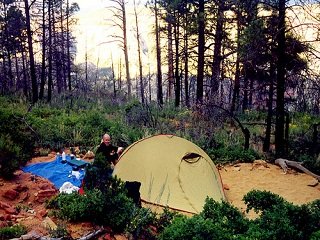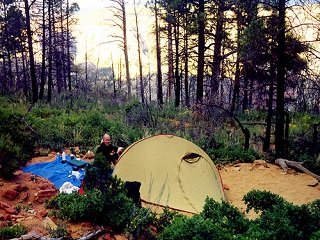 For many, camping is an RV or a campground with an established site, complete with fire pit or grill and a bathroom nearby. There’s nothing wrong with this, of course, as the real aim of reaching the outdoors is to get away from our everyday stress. However, there are also some of us who venture out for a weekend of hiking in remote areas with nothing more than what we’re able to carry. Backcountry campers are a different breed, in that they make camp wherever they happen to be on the trail once the light begins to fade. This can pose a few challenges, however, and there are a few things to keep in mind when choosing an appropriate backcountry campsite.
For many, camping is an RV or a campground with an established site, complete with fire pit or grill and a bathroom nearby. There’s nothing wrong with this, of course, as the real aim of reaching the outdoors is to get away from our everyday stress. However, there are also some of us who venture out for a weekend of hiking in remote areas with nothing more than what we’re able to carry. Backcountry campers are a different breed, in that they make camp wherever they happen to be on the trail once the light begins to fade. This can pose a few challenges, however, and there are a few things to keep in mind when choosing an appropriate backcountry campsite.
Obviously, you’ll want to locate a flat piece of land, or at least one that’s as flat as possible. If a level site isn’t available, then do your best to sleep with your head higher than your feet. It may be hard, in certain regions of the country, to find a site free of rocks, but do the best you can to clear the site of moveable rocks. Small as they may be, rocks can damage your tent, so a ground sheet is a good idea, as well. If you do end up moving rocks in order to sleep, it’s always best to replace them in the morning.
The elements will also play a role in determining a suitable location in which to camp in the backcountry and remembering a few important facts will help immensely. Firstly, keep in mind that rain drains downhill, which means you should probably refrain from setting up camp at the base of any hills or other mountainous formations. Also, try not to pitch your tent in a wide open area where wind will wreak havoc all night. Not only will wind make it quite cold inside your tent, but the perpetual noise of your tent flapping in the gusts all night will most likely keep you from falling asleep.
Other than that, it pays to simply check around your desired location for other signs of potential discomfort, such as anthills, beehives, poisonous plants, etc. Try to stay clear of standing water, such as ponds and marshes, as insects usually congregate near such areas.
While it may seem like the first flat piece of land you find is as good a spot as any at the end of a long day, taking a few minutes to survey the area may prove otherwise. Sometimes a short walk downriver or along the path will reveal a more optimal location. Try to keep the tips outlined above in mind the next time you hit the backcountry and you’ll find that your trip will be more comfortable, which, of course, means more enjoyable.








